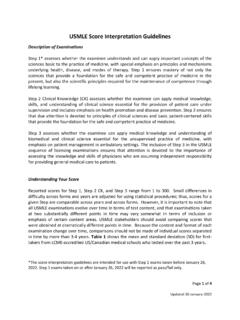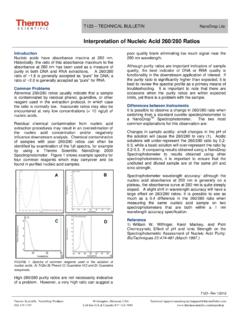Transcription of Summary and Work Group Interpretation
1 Summary and Work Group Interpretation : Extended intervals for mRNA COVID-19 vaccines Sara Oliver, MD, MSPH. ACIP Meeting February 4, 2022. Policy question for previous ACIP vote Should vaccination with the Moderna COVID-19 vaccine (Spikevax, 2-dose primary series) be recommended for persons 18 years of age and older? Regulatory action, GRADE, Evidence to Recommendation Framework, Vote Moderna No Compared to COVID-19 vaccine COVID-19 vaccine 2. Question for discussion Based on new and emerging data, should CDC consider guidance around the interval between dose 1 and 2 for mRNA COVID-19. vaccines? Implementation;. Discussions around myocarditis and intervals Moderna Pfizer-BioNTech And COVID-19 vaccine COVID-19 vaccine 3. VaST assessment Myocarditis/pericarditis following Moderna and Pfizer-BioNTech COVID-19 vaccination VaST reviewed the most recent data from three safety monitoring systems*, and well as data from international partners Reported rates of myocarditis/pericarditis following mRNA COVID-19 vaccination are higher than background; rates are highest after dose 2 in adolescent and young adult males In most safety monitoring systems, myocarditis/pericarditis risk appears higher after dose 2 Moderna than dose 2 Pfizer-BioNTech COVID-19 vaccination Data are limited on myocarditis/pericarditis risk following different dose 1-dose 2.
2 Intervals+. VaST: Vaccine Safety Technical (VaST) Work Group *VAERS, v-safe, VSD. +Source: Buchan S et al. Dec 2021, MedRxiv preprint. 4 4. Summary : International data Myocarditis after mRNA COVID-19 vaccines Risk of myocarditis/pericarditis was higher for Moderna than Pfizer vaccine The highest risk was seen after the second dose among younger males Rates of myocarditis/pericarditis were lower with extended interval ( 8 weeks) between first and second dose of mRNA vaccine primary series 5. Summary Extended primary series interval and mRNA COVID-19 vaccine effectiveness An extended primary series interval may improve immunogenicity and vaccine effectiveness Antibody responses were higher following an extended interval (6 14 weeks). between the first and second doses of mRNA vaccine, compared to a standard interval (3 4 weeks). mRNA vaccine effectiveness against infection and hospitalization was higher with an extended interval (6 8 weeks), compared to a standard interval (3 4.)
3 Weeks). 6. Benefits and risks balance for mRNA COVID-19 vaccines Adults ages 18 39 years Benefits Risks mRNA COVID-19 vaccines mRNA COVID-19 vaccines Moderna COVID-19 vaccine Moderna COVID-19 vaccine Pfizer-BioNTech COVID-19 vaccine Pfizer-BioNTech COVID-19 vaccine 7. Methods for assessment of benefit-risk balance Benefits Calculated per 1 million fully vaccinated people Age Group : 18 39 years Selected because this age Group has the highest rates of myocarditis and lowest hospitalization rates among adults, and would therefore have the closest benefit/risk margin Age/sex specific hospitalization rates: COVID-NET (average of rates from Dec 11-Jan 1, 2022)1. Pooled vaccine-specific VE estimates from two platforms2. Time Horizon: 150-day period Harms Calculated per 1 million fully vaccinated people Vaccine-specific myocarditis rates from Vaccine Safety Datalink (VSD). VE: Vaccine Effectiveness 1 2 #vaccine-effectiveness 8. Vaccine-specific estimates of effectiveness against COVID-19.
4 Hospitalization VE against COVID-19 hospitalization1. IVY Network2, VISION2, Aug . Oct Nov, 2021 Dec, 2021, % Pooled VE. % (95% CI) (95% CI) Estimate Moderna 91 (89-93) 92 (91-93) 92. Pfizer- 86 (83-88) 87 (86-88) 87. BioNTech VE= vaccine effectiveness; VE reported for 2 doses of mRNA COVID-19 vaccines 1. #vaccine-effectiveness 2. VE estimate for 17-179 days after 2nd dose 9. Reporting rates of myocarditis following mRNA COVID-19 vaccination (per million 2nd doses administered) among persons ages 18 39 years1. Rate per 1M 2nd Doses in 7-day risk Vaccine Sex period among persons ages 18 39 years2. Moderna Males All Pfizer-BioNTech Males All 1. Data from the Vaccine Safety Datalink (VSD): 2. Data through Jan 15, 2022. 10. Benefits and risks after mRNA COVID-19 vaccines among persons ages 18 39 years per million 2nd doses COVID-19-associated hospitalizations prevented by mRNA COVID-19 vaccines compared with myocarditis cases expected Presented by vaccine product COVID-19-Associated Hospitalizations Prevented per Cases of Myocarditis Expected per Million 2nd Million 2nd Doses of Moderna and Pfizer-BioNTech Vaccine Age Group Doses of Moderna and Pfizer-BioNTech Vaccine (years).
5 2982 33. 18-39. 2820 24. 3000 2500 2000 1500 1000 500 0 0 100 200 300 400 500.. 11. Benefits and risks after mRNA COVID-19 vaccines among males ages 18 39 years per million 2nd doses COVID-19-associated hospitalizations prevented by mRNA COVID-19 vaccines compared with myocarditis cases expected Presented by vaccine product COVID-19-Associated Hospitalizations Prevented per Cases of Myocarditis Expected per Million 2nd Million 2nd Doses of Moderna and Pfizer-BioNTech Vaccine Age Group Doses of Moderna and Pfizer-BioNTech Vaccine (years). 1903 68. 18-39. 1799 47. 2000 1500 1000 500 0 0 100 200 300 400 500.. 12. Limitations Benefit-risk analysis focuses on individuals 18 39 years of age, considers direct benefits and risk over a 150-day period, and compares vaccine vs. no vaccine VE assumptions used in the model do not yet include Omicron-specific VE estimates The model assumes static hospitalization rate over 5 months Benefit/risk profile might change as hospitalization rates change Model does not account for booster doses or prior infection 13.
6 Benefits and risks balance for mRNA COVID-19 vaccines Risks Benefits COVID-19 hospitalizations averted Myocarditis after Moderna by Moderna COVID-19 vaccine COVID-19 vaccine likely greater greater than Pfizer-BioNTech than Pfizer-BioNTech COVID-19. COVID-19 vaccine vaccine 14. 14. Summary : Benefit/risk balance Benefits for both mRNA COVID-19 vaccines far outweigh risk of myocarditis, compared with no vaccine When compared to the benefit-risk balance for Pfizer-BioNTech COVID-19. vaccine, the Moderna vaccine prevents more COVID-19 hospitalizations, however more myocarditis cases would also be expected 15. Summary : Myocarditis and Intervals When comparing the two mRNA COVID-19 vaccines, the risk of myocarditis/pericarditis was higher for Moderna than Pfizer vaccine The highest risk was seen after the second dose among younger males Rates of myocarditis/pericarditis were lower with extended interval between first and second dose of mRNA vaccine primary series Extended primary series interval may improve immunogenicity and vaccine effectiveness 16.
7 Question for discussion Based on new and emerging data, should CDC consider guidance around the interval between dose 1 and 2 for mRNA COVID-19. vaccines? Implementation; Discussions around myocarditis and intervals Moderna Pfizer-BioNTech And COVID-19 vaccine COVID-19 vaccine 17. Who would this apply to? Number and percent of people with 0 doses administered, by age Group Age Group Number (M) Percent ~33 million 12 17 yrs 35. unvaccinated 18 24 yrs 25. individuals ages 25 39 yrs 25. 12 39 years 40 49 yrs 15. 50 64 yrs 8. 65 74 yrs 5. 75+ yrs 5. Source: #vaccinations_vacc-people-onedose-pop-5y r 18. Considerations regarding extended intervals between first and second doses of mRNA vaccine (primary series). Possible Benefits Safety: Extended interval appears to reduce the risk of myocarditis Lowest rates of myocarditis with interval at 8 weeks Effectiveness: Extended interval appears to increase VE for primary series Benefit may level out' at 8 weeks Implementation: Possibility that uptake for COVID-19 vaccine primary series could increase if individuals/parents desire action to lower risk for myocarditis 19.
8 Considerations regarding extended intervals between first and second doses of mRNA vaccine (primary series). Possible Risks Effectiveness: Longer duration of time where individual only have the benefit of a single dose of mRNA vaccine Implementation: For aspects that require being fully vaccinated' (shorter quarantine, travel or restaurants, etc), extending interval would extend the time before being fully vaccinated'. 20. Work Group Interpretation An individual's risk of getting COVID-19 likely increases the longer they are only partially vaccinated with a single dose The risk would need to be balanced with the benefits of lowering rates of myocarditis and optimizing the long-term vaccine effectiveness This balance is influenced by trajectory of pandemic and recent epidemiology of COVID-19, and can change over time Early in the pandemic, the priority was for individuals to have optimum protection from the primary series as quickly as possible Guidance around COVID-19 vaccines can be updated as new data become available and the focus expands to the future of the COVID-19 vaccine program 21.
9 Work Group Interpretation Clear communication for COVID-19 vaccines and preferred intervals is important May be populations where the benefits of earlier interval (3 or 4 weeks) would outweigh possible risks of myocarditis Licensed intervals of 3 weeks (Pfizer-BioNTech) or 4 weeks (Moderna) continue to be recommended, especially in circumstances where early protection is desired The Work Group supported a preferred interval of 8 weeks between the first and second dose of an mRNA COVID-19 vaccine primary series 22. Acknowledgments Monica Godfrey Stephen Hadler Megan Wallace Valerie Morelli Amy Blain JoEllen Wolicki Amimah Asif Elisha Hall Danielle Moulia Erin Ricketts Katie Curran Faisal Minhaj Sarah Mbaeyi Heather Scobie Evelyn Twentyman VTF ACIP WG Team Tara Jatloui ACIP COVID-19 Vaccines Work Group Susan Goldstein Vaccine Task Force Jack Gersten Epi Task Force Jefferson Jones Data Analytics and Visualization Task Force Eddie Shanley Respiratory Viruses Branch Anthony Fiore Questions for ACIP.
10 What does ACIP think about an extended interval between the first and second doses of the mRNA COVID-19 vaccine primary series? What time frame does ACIP think would be preferred for the interval between first and second doses of the mRNA COVID-19 vaccine primary series? 24. Thank you For more information, contact CDC. 1-800-CDC-INFO (232-4636). TTY: 1-888-232-6348 The findings and conclusions in this report are those of the authors and do not necessarily represent the official position of the Centers for Disease Control and Prevention.












